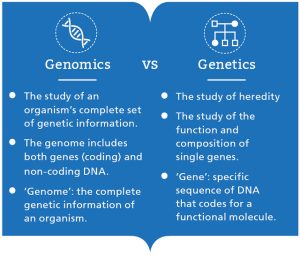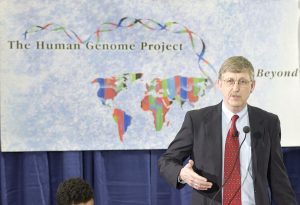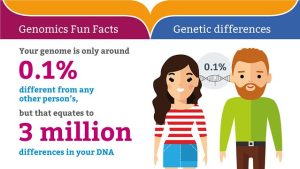1.2 Genetics and Genomics Introduction
Understanding Genomics
Genetics and Genomics – What’s the Difference?
Genetics and genomics both play roles in health and disease. Genetics refers to the study of genes and the way that certain traits or conditions are passed down from one generation to another. Genomics describes the study of all of a person’s genes (the genome).
Genetics is a term that refers to the study of genes and their roles in inheritance – in other words, the way that certain traits or conditions are passed down from one generation to another. Genetics involves scientific studies of genes and their effects. Genes (units of heredity) carry the instructions for making proteins, which direct the activities of cells and functions of the body. Examples of genetic or inherited disorders include cystic fibrosis (See: Learning About Cystic Fibrosis), Huntington’s disease (Learning About Huntington’s Disease), and phenylketonuria (PKU) (Learning About Phenylketonuria).
Genomics is a more recent term that describes the study of a person’s genes (the genome), including interactions of those genes with each other and the person’s environment. Genomics includes the scientific study of complex diseases such as heart disease, asthma, diabetes, and cancer because these diseases are typically caused more by a combination of genetic and environmental factors than by individual genes. Genomics offers new possibilities for therapies and treatments for some complex diseases and new diagnostic methods.

Personalized medicine (or healthcare) is an emerging practice that uses an individual’s genetic profile to guide decisions made regarding disease prevention, diagnosis, and treatment. Knowing a patient’s genetic profile can help doctors select the proper medication or therapy and administer it using the appropriate dose or regimen. Personalized medicine is being advanced through data from the Human Genome Project.
Personalized medicine is a fantastic opportunity to take a “one size fits all” approach to diagnostics, drug therapy, and prevention and turn it into an individualized approach. We all are similar, of course, but we are also different. The idea that medicine would be applied in a fashion that ignores those differences can’t be any more correct than going to the shoe store and buying any old pair of shoes without checking the size. Genomics plays a significant role in the emergence of personalized medicine as it gives us a window in a particular molecular way into those differences between us and allows the opportunity for making individual predictions about disease risk that can help somebody choose a prevention plan that is right for them. It also allows the possibility, in some instances, of picking the right drug at the right dose for the right person instead of the “one size fits all” approach to drug therapy. And ultimately, it will be hard to see how any kind of medicine will not be affected by this as we learn more and more about the individual and as many of us find our complete genomes being sequenced and placed into our medical records to empower that kind of personalized approach. Lots of work to do here, but it may be the biggest revolution in medicine in a very long time.
Precision medicine is a newer term with a similar meaning to the often analogously used “personalized medicine or healthcare.” The shift away from the word personalized was in response to concerns over misinterpretation of the word “personalized” to imply that each individual could have uniquely tailored care and treatment. Precision medicine/healthcare takes advantage of large data sets of individuals such as their genome or their entire electronic health record to tailor their healthcare to their unique attributes. “Precision medicine consists of identifying which approaches/treatment will be effective for which patients according to the group to which they belong based on their biological characteristics. In this sense, it is more stratified medicine than personalized medicine” (Delpierre & Lefèvre, 2023). It is common sense that no two individuals are the same, so they should not get the same healthcare. Precision healthcare embodies that simple idea.
Personalized Medicine (text version)
Watch the video Personalized Medicine (5 mins) at BC Campus Media
Pause the video at 4:25 to answer the following question:
True or false? How drugs interact with your unique genetic makeup is a part of personalized medicine.
Check your answer in footnote[1]
Activity source: Concepts of Biology – 1st Canadian Edition, CC BY 4.0
The Human Genome Project
The Human Genome Project (HGP) is one of the most remarkable scientific feats in history. The project was a voyage of biological discovery led by an international group of researchers looking to comprehensively study all of the DNA (known as a genome) of a select set of organisms. Launched in October 1990 and completed in April 2003, the Human Genome Project’s signature accomplishment – generating the first sequence of the human genome – provided fundamental information about the human blueprint, which has since accelerated the study of human biology and improved the practice of medicine.
Checkout this Human Genome Project timeline of events from the NHGRI
Visit NHGRI to learn more about the Human Genome Project.

Facts About the Human Genome
- Humans have approximately 80,000 genes (source: GENCODE v.49)
- DNA contains 6 billion nucleotides, which amounts to 3 billion base pairs.
- There is a 99.9% similarity in the DNA sequences of humans.
- A human gene may have 1-3 letters that differ from person to person.
- Humans have 23 pairs of chromosomes

Watch History – Making Sense of the Human Genome (4 mins) on YouTube
Video source: National Human Genome Research Institute. (2015, March 19). History® – Making sense of the human genome [Video]. YouTube. https://www.youtube.com/watch?v=iHuUkb-Mvz8
Genomics Applications
Why Are Genetics and Genomics Important to Health?
Genetics and genomics both play roles in health and disease. Genetics helps individuals and families learn about how conditions such as sickle cell anemia and cystic fibrosis are inherited in families, what screening and testing options are available, and, for some genetic conditions, what treatments are available.
Genomics is helping researchers discover why some people get sick from certain infections, environmental factors, and behaviours while others do not. For example, some people exercise their whole lives, eat a healthy diet, have regular medical checkups, and die of a heart attack at age 40. Some people smoke, never exercise, eat unhealthy foods and live to be 100. Genomics may hold the key to understanding these differences.
Apart from accidents (such as falls, motor vehicle accidents or poisoning), genomic factors play a role in nine of the ten leading causes of death in the United States (for example, heart disease, cancer and diabetes. See: Leading Causes of Death). All human beings are 99.9 percent identical in their genetic makeup. Differences in the remaining 0.1 percent hold important clues about the causes of diseases. Gaining a better understanding of the interactions between genes and the environment using genomics is helping researchers find better ways to improve health and prevent disease, such as modifying diet and exercise plans to prevent or delay the onset of type 2 diabetes in people who carry genetic predispositions to developing this disease.
Why Are Genetics and Genomics Important to the Health of Families?
Understanding more about diseases caused by a single gene (using genetics) and complex diseases caused by multiple genes and environmental factors (using genomics) can lead to earlier diagnoses, interventions, and targeted treatments. A person’s health is influenced by their family history and shared environmental factors. This makes family history an important, personalized tool that can help identify many of the causative factors for conditions with a genetic component. The family history can serve as the cornerstone for learning about genetic and genomic conditions in a family and for developing individualized approaches to disease prevention, intervention, and treatment.
Concept in Action
Watch My Genomics Journey: three perspectives (5 mins) on Vimeo
Video source: Genomics Education Programme. (2023, November 27.). My genomics journey: Three perspectives [Video]. Vimeo. https://vimeo.com/888710908
15 ways genomics influences our world:
- DNA sequencing – Advances in genomics are reducing the cost of genome sequencing by a million-fold.
- Human genomic variation – Genomics is helping us understand what makes each of us different and what makes us the same.
- Cancer genomics – Genomics transforms how we study, diagnose and treat cancer.
- Human origins and ancestry – Genomics is illuminating human and family origins at a previously impossible level.
- Agriculture – Genomics is empowering farmers to improve the food supply.
- Genomes at work – We are learning how our genomes serve as blueprints for life.
- Rare genetic diseases – Genomics is ending diagnostic odysseys for patients with rare diseases.
- Pharmacogenomics – Genomics is helping us choose the right medication at the right dose for each patient.
- Noninvasive prenatal genetic testing – Genomics is revolutionizing health assessments before birth.
- Enhanced forensics – Genomics establishes more robust methods for DNA-based forensic analyses.
- Microbes and microbiomes – Genomics is advancing the study of individual and communities of microbes.
- Direct-to-consumer genomic testing – Genomics is helping you access information about your genome from your home.
- The natural world – Genomics helps us understand evolution and protect our biological ecosystems.
- Genome editing – Genomics alters a genome with unparalleled efficiency and precision.
- Social context – Genomics fosters an appreciation of what our DNA means for our health, identities and culture.
To view this source and for more details on these applications, visit NHGRI.
Genomic Literacy
What exactly is meant by “genomic literacy?”
Watch the short animation Canadian Nursing and Genomics: Whiteboard Video 1 (1 minute) on YouTube
Video source: Limoges, J.. (2022, January 22). Canadian nursing and genomics: Whiteboard video 1 [Video]. YouTube. https://www.youtube.com/watch?v=4yYfMNE39JE
Evidence Informing the Definition of Genomic Literacy
Boerwinkel et al. (2017) conducted a Delphi study to achieve expert consensus on the essential knowledge required for informed decision-making in genomics. Genomic literacy is necessary not only for healthcare professionals delivering genomic services but also for patients receiving them. The authors classified this knowledge into three categories:
Conceptual knowledge: knowledge of genetic concepts;
Sociocultural knowledge: knowledge of how applications of genetic technologies are used in societal activities and in what ways they influence human lives;
Epistemic knowledge: knowledge of the meaning of genetic information. This concerns the knowledge needed to interpret genetic information from different sources and how to use these in argument and decision-making. This knowledge includes Nature of Science aspects such as the certainty and uncertainty of genetic information and how genetic concepts have evolved (Boerwinkel et al., 2017, p.1106).
How Can Genomic Literacy Assist Nurses in Addressing the Social, Ethical, and Equity Issues Associated with Nursing?
Watch this short animation: Canadian Nursing and Genomics Whiteboard Video 4 (2 mins) from YouTube
Video source: Limoges, J. (2022, March 31). Canadian nursing and genomics whiteboard video 4 [Video]. YouTube. https://www.youtube.com/watch?v=IFo8IgltQDY
Attribution & References
Except where otherwise noted, content on this page is adapted from the following sources.
- Genetics vs. Genomics Fact Sheet, Courtesy of: National Human Genome Research Institute, Public Domain with attribution
- Personalized Medicine, Courtesy of: National Human Genome Research Institute, Public Domain with attribution
- Precision Medicine, Courtesy of: National Human Genome Research Institute, Public Domain with attribution
- 15 Ways Genomics Influences Our World, Courtesy of: National Human Genome Research Institute, Public Domain with attribution
- H5P/video from 10.3 Genomics and Proteomics In Concepts of Biology – 1st Canadian Edition by , CC BY 4.0
Adaptations include combining sources, minor grammatical changes, and addition of quotes, videos and commentary to improve student understanding.
References
Boerwinkel, D.J., Yarden, A. & Waarlo, A.J. (2017). Reaching a consensus on the definition of genetic literacy that is required from a twenty-first-century citizen. Science & Education, 26, 1087–1114. https://doi.org/10.1007/s11191-017-9934-y
Delpierre, C., & Lefèvre, T. (2023). Precision and personalized medicine: What their current definition says and silences about the model of health they promote. Implication for the development of personalized health. Frontiers in Sociology, 8, 1112159. https://doi.org/10.3389/fsoc.2023.1112159
- True ↵
Genetics is the branch of biology concerned with the study of inheritance, including the interplay of genes, DNA variation and their interactions with environmental factors.
Genomics is a field of biology focused on studying all the DNA of an organism — that is, its genome. Such work includes identifying and characterizing all the genes and functional elements in an organism’s genome as well as how they interact.
The genome is the entire set of DNA instructions found in a cell. In humans, the genome consists of 23 pairs of chromosomes located in the cell’s nucleus, as well as a small chromosome in the cell’s mitochondria. A genome contains all the information needed for an individual to develop and function.
The gene is considered the basic unit of inheritance. Genes are passed from parents to offspring and contain the information needed to specify physical and biological traits. Most genes code for specific proteins, or segments of proteins, which have differing functions within the body. Humans have approximately 20,000 protein-coding genes.
Proteins are large, complex molecules that play many important roles in the body. They are critical to most of the work done by cells and are required for the structure, function and regulation of the body’s tissues and organs. A protein is made up of one or more long, folded chains of amino acids (each called a polypeptide), whose sequences are determined by the DNA sequence of the protein-encoding gene.
Inherited, as related to genetics, refers to a trait or variants encoded in DNA and passed from parent to offspring during reproduction. Inheritance is determined by the rules of Mendelian genetics.
Precision medicine (generally considered analogous to personalized medicine or individualized medicine) is an innovative approach that uses information about an individual’s genomic, environmental and lifestyle information to guide decisions related to their medical management. The goal of precision medicine is to provide more a precise approach for the prevention, diagnosis and treatment of disease.
The Human Genome Project was a large international, collaborative effort that mapped and sequenced the human genome for the first time. Conducted from 1990 to 2003, the project was historic in its scope and scale as well as its groundbreaking approach for the free release of genomic data well ahead of publication, leading to a new ethos for data sharing in biomedical research.
A family history, as related to medicine, is a record of the diseases and health conditions of an individual and that person’s biological family members, both living and deceased. A family history can help determine whether someone has an increased genetic risk of having or developing certain diseases, disorders or conditions. It is often recorded by drawing a pedigree (a family tree) that illustrates the relationships among individuals.

